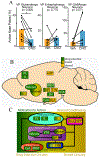Circuit selectivity in drug versus natural reward seeking behaviors
- PMID: 33420731
- PMCID: PMC8178159
- DOI: 10.1111/jnc.15297
Circuit selectivity in drug versus natural reward seeking behaviors
Abstract
Substance use disorder (SUD) is characterized, in part by behavior biased toward drug use and away from natural sources of reward (e.g., social interaction, food, sex). The neurobiological underpinnings of SUDs reveal distinct brain regions where neuronal activity is necessary for the manifestation of SUD-characteristic behaviors. Studies that specifically examine how these regions are involved in behaviors motivated by drug versus natural reward allow determinations of which regions are necessary for regulating seeking of both reward types, and appraisals of novel SUD therapies for off-target effects on behaviors motivated by natural reward. Here, we evaluate studies directly comparing regulatory roles for specific brain regions in drug versus natural reward. While it is clear that many regions drive behaviors motivated by all reward types, based on the literature reviewed we propose a set of interconnected regions that become necessary for behaviors motivated by drug, but not natural rewards. The circuitry is selectively necessary for drug seeking includes an Action/Reward subcircuit, comprising nucleus accumbens, ventral pallidum, and ventral tegmental area, a Prefrontal subcircuit comprising prelimbic, infralimbic, and insular cortices, a Stress subcircuit comprising the central nucleus of the amygdala and the bed nucleus of the stria terminalis, and a Diencephalon circuit including lateral hypothalamus. Evidence was mixed for nucleus accumbens shell, insular cortex, and ventral pallidum. Studies for all other brain nuclei reviewed supported a necessary role in regulating both drug and natural reward seeking. Finally, we discuss emerging strategies to further disambiguate the necessity of brain regions in drug- versus natural reward-associated behaviors.
Keywords: addiction; drug seeking; natural reward; nucleus accumbens; reward circuit; stress circuit.
© 2021 International Society for Neurochemistry.
References
-
- Addy NA, Nunes EJ, Hughley SM, Small KM, Baracz SJ, Haight JL, & Rajadhyaksha AM (2018). The L-type calcium channel blocker, isradipine, attenuates cue-induced cocaine-seeking by enhancing dopaminergic activity in the ventral tegmental area to nucleus accumbens pathway. Neuropsychopharmacology, 43(12), 2361–2372. - PMC - PubMed
-
- Agboola SA, Coleman T, McNeill A, & Leonardi-Bee J (2015). Abstinence and relapse among smokers who use varenicline in a quit attempt-a pooled analysis of randomized controlled trials. Addiction, 110(7), 1182–1193. - PubMed
-
- American Psychiatric Association. (2013). Diagnostic and statistical manual of mental disorders. American Psychiatric Pub; (4th ed., T). Washington DC.
Publication types
MeSH terms
Grants and funding
- I01 BX004727/BX/BLRD VA/United States
- P20GM121310/University of Wyoming
- DA012513/DA/NIDA NIH HHS/United States
- DP5 OD026407/OD/NIH HHS/United States
- DA003906/DA/NIDA NIH HHS/United States
- BX004727/U.S. Department of Veterans Affairs
- DA046373/DA/NIDA NIH HHS/United States
- U01 DA045300/DA/NIDA NIH HHS/United States
- P20 GM121310/GM/NIGMS NIH HHS/United States
- R00 DA046522/DA/NIDA NIH HHS/United States
- R37 DA003906/DA/NIDA NIH HHS/United States
- P50 DA046373/DA/NIDA NIH HHS/United States
- R01 DA012513/DA/NIDA NIH HHS/United States
- K99 DA046522/DA/NIDA NIH HHS/United States
- R01 DA003906/DA/NIDA NIH HHS/United States
- DP5 OD026407/CD/ODCDC CDC HHS/United States
- DA046522/DA/NIDA NIH HHS/United States
LinkOut - more resources
Full Text Sources
Other Literature Sources


